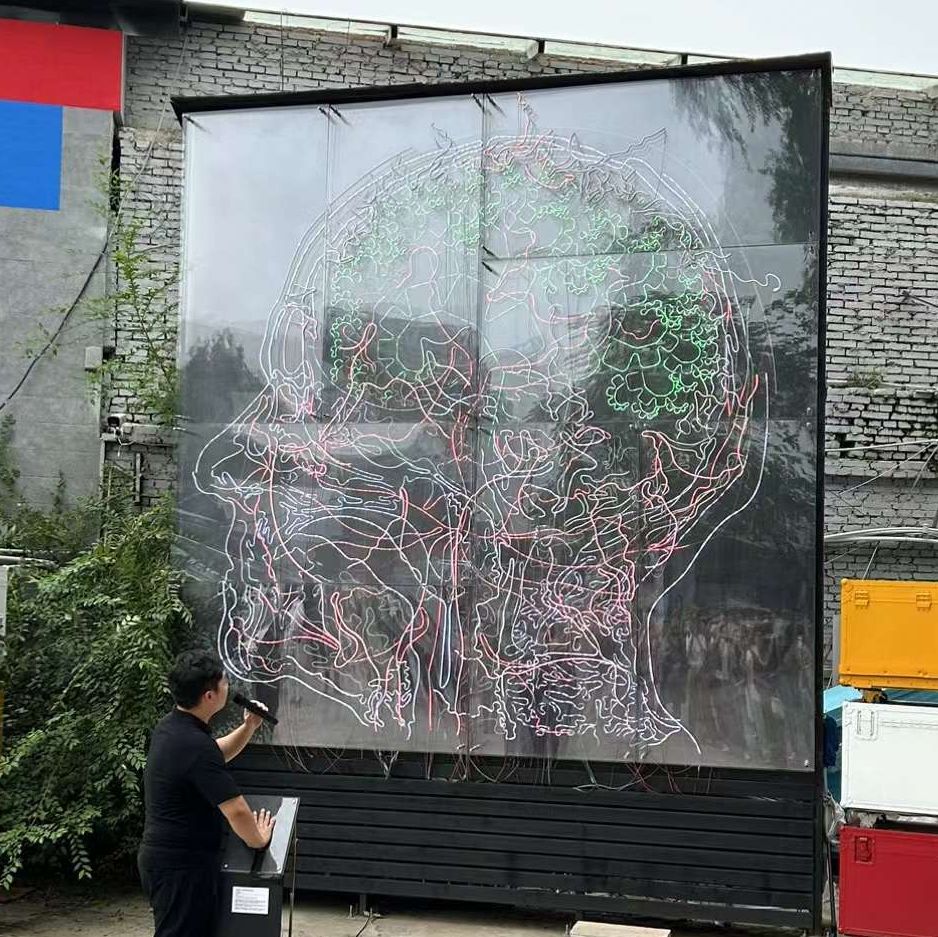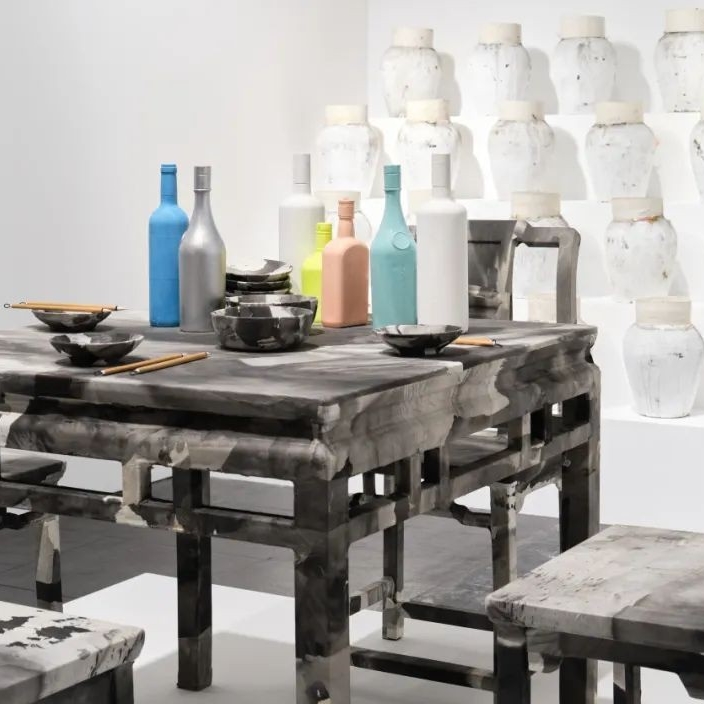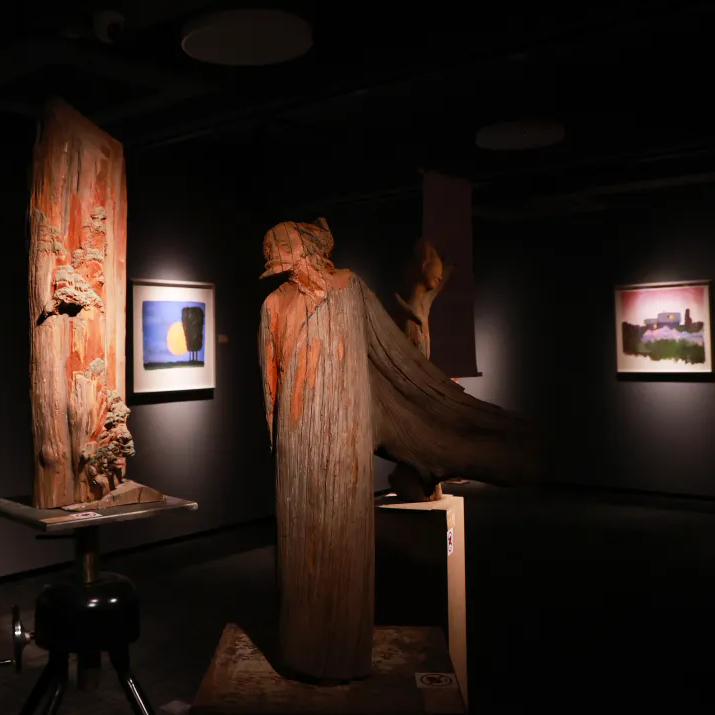“I found myself in a landscape reminiscent of the Western Regions, particularly the ancient city Loulan that has long since vanished. I stood atop a hill, observing my distant self—undeniably me—I turned to the setting sun.” —Kang Chunhui
“Observing My Distant Self: Kang Chunhui”, presented by INKstudio in Beijing, unfolds in two distinct sections: “Observing My Distant Self” and “Undeniably Me”. This female artist who was born in the 1980s specializes in Chinese painting. With her premiere solo exhibition at INKstudio and her latest art project of Xinjiang, she hopes to offer an immersive journey into a crucial juncture in her artistic development, which includes both warm review and rational identification.

 Kizilgaha Beacon 82°90′95E-41°79′87N (screenshot), Color Video, sound, 06’06”
Kizilgaha Beacon 82°90′95E-41°79′87N (screenshot), Color Video, sound, 06’06”
Occupying the entirety of INKstudio’s ground floor, Observing My Distant Self 73°40′E~96°23′E 34°25′N~48°10′N, 2019-2023, is an expansive eight-part multimedia project responding to Kang’s childhood dream in the form of a metaphorical pilgrimage to the Western Regions. As the artist has put forward, through this creative journey she has experienced in her hometown of Xinjiang, she wanted to distinguish and clarify, “Why do I paint? Did painting choose me, or did I choose it?” What she is eagerly looking forward to is not an exact answer. But it is a process, a direction and a possibility.
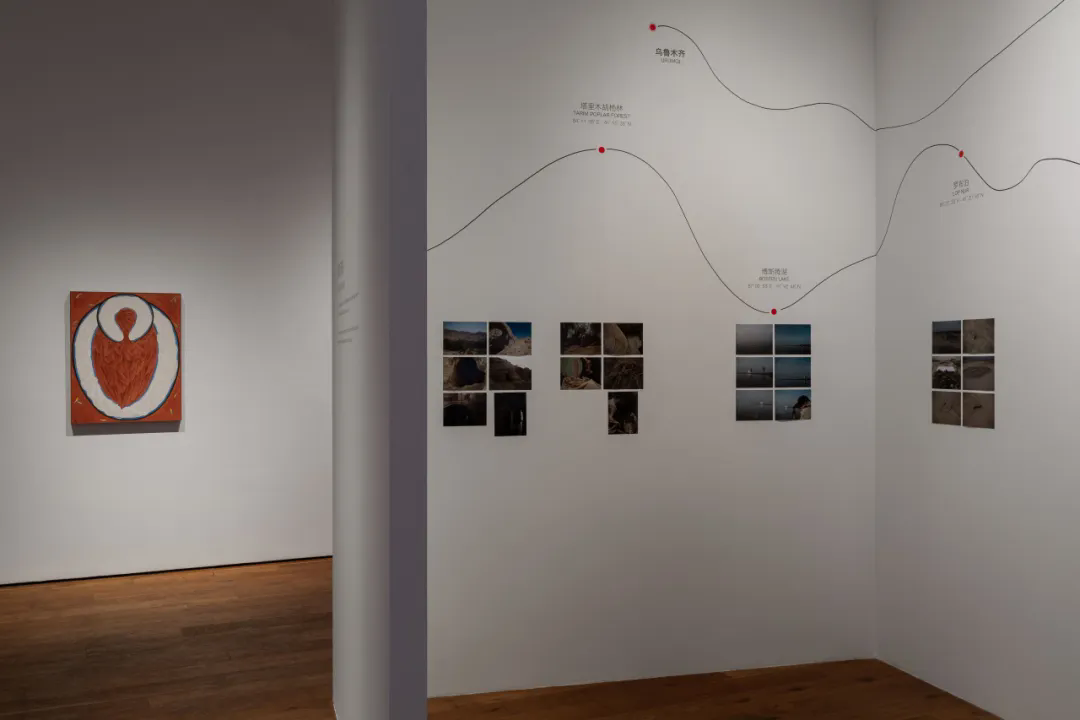
 Installation View of “Observing My Distant Self Kang Chunhui”, 2024.5.25-8.18, INKstudio
Installation View of “Observing My Distant Self Kang Chunhui”, 2024.5.25-8.18, INKstudio
I. From Dream to Reality, From Painting to Moving Images
Almost an enigmatic prophecy, the vivid childhood dreamscape lingered in the subconscious of visual artist Kang Chunhui (Urumqi, Xinjiang, 1982) for over three decades, until last year, 2023, when the time came for her to revisit its mystique with renewed urgency. On her pilgrimage Kang makes eight stops: the Kumtag Desert, Lop Nur, Bosten Lake, Tarim Poplar Forest, Kuqa Old Town, Tianshan Grand Canyon, Kizilgaha Beacon, and the Kizil Caves. Eight 6’6”-long videos place an aspect of Kang’s artistic practice in spatial dialog with a location in Xinjiang selected by Kang for its historical, sociological, and cultural significance. Throughout her journey, Kang explores the boundaries between place, history, memory, self and creativity, conceiving them not as rigid territories but as expansive areas for exploration, exchange, synthesis and transformation.
 Installation View of “Observing My Distant Self Kang Chunhui”, 2024.5.25-8.18, INKstudio
Installation View of “Observing My Distant Self Kang Chunhui”, 2024.5.25-8.18, INKstudio Kuqa Old Town 82°93′12E-41°72′47N(painting), Ink and mineral pigment on paper and glass,100 x 100 cm
Kuqa Old Town 82°93′12E-41°72′47N(painting), Ink and mineral pigment on paper and glass,100 x 100 cm Kizil Caves 82°51′35E-41°78′82N (screenshot), Color Video, sound, 06’06”
Kizil Caves 82°51′35E-41°78′82N (screenshot), Color Video, sound, 06’06” Kizil Caves 82°51′35E-41°78′82N (painting), Ink and mineral pigment on paper, 60 x 40 cm
Kizil Caves 82°51′35E-41°78′82N (painting), Ink and mineral pigment on paper, 60 x 40 cm
Different from the previous creative sequence of conception, drafting and painting, Kang took use of video for the first time as a more directive medium in Observing My Distant Self 73°40′E~96°23′E 34°25′N~48°10′N, 2023- 2024, “recording” her representative works at different stages of creation, and her dialogues with the specific venues and natural landscape of lake, desert, old town, Gobi, cave, and mountain in Xinjiang. In these 8 sets of corresponding paintings and videos, these “confrontations” between matters, elements refresh the artist’s comprehensively new thinking and feeling of reality and fiction, nature and man-made objects, history and the present, and even the tradition of Chinese painting itself which were all centered around “the boundary.”
 Installation View of “Observing My Distant Self Kang Chunhui”, 2024.5.25-8.18, INKstudio
Installation View of “Observing My Distant Self Kang Chunhui”, 2024.5.25-8.18, INKstudio Bosten Lake 87°02′58E-41°92′46N (painting), Ink and mineral pigment on paper, 69 x 93 cm
Bosten Lake 87°02′58E-41°92′46N (painting), Ink and mineral pigment on paper, 69 x 93 cm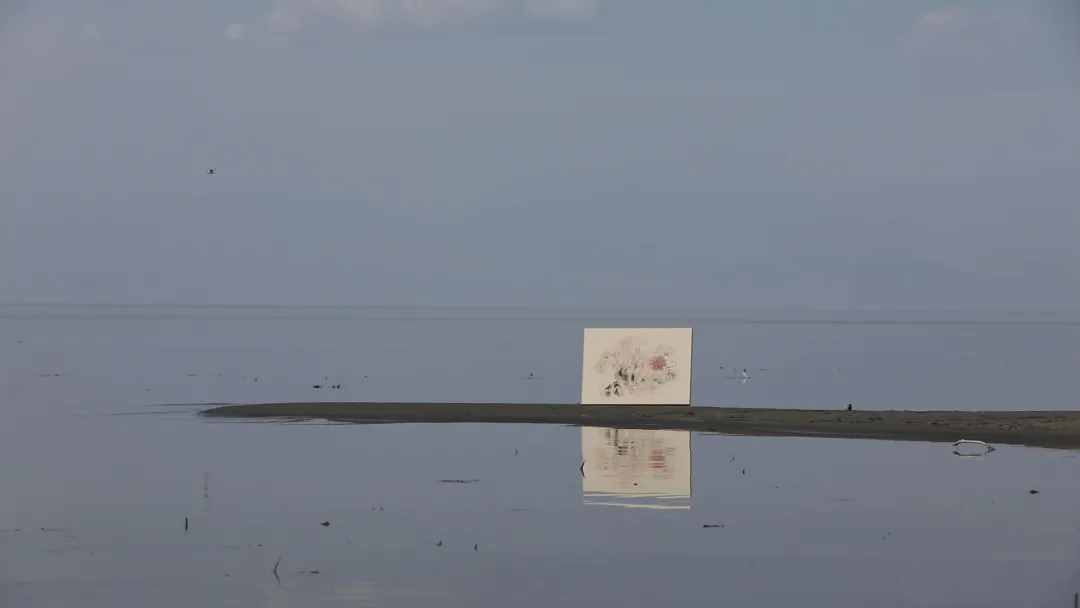 Bosten Lake 87°02′58E-41°92′46N (screenshot), Color Video, sound, 06’06”
Bosten Lake 87°02′58E-41°92′46N (screenshot), Color Video, sound, 06’06”
II. Contemplating the Boundary
Having been trained in Chinese traditional gongbi or “meticulous brush” painting since her youth, Kang Chunhui sometimes felt that art used to be a passive choice. She started studying oil painting at the age of 14. When she was in college, she turned to studying public art. For the postgraduate study, she went to Seoul to study video art. After having in-depth exposure to almost all mainstream media and categories in the current art world, she increasingly felt that Chinese painting still has a huge influence on her. She returned to the flower-and-bird genre of Chinese painting, with a more transcendent and groundbreaking consciousness in her creation.
 Installation View of “Observing My Distant Self Kang Chunhui”, 2024.5.25-8.18, INKstudio
Installation View of “Observing My Distant Self Kang Chunhui”, 2024.5.25-8.18, INKstudio Kumtag Desert 90°33′27E-42°84′86N (screenshot), Color Video, sound, 06’06”
Kumtag Desert 90°33′27E-42°84′86N (screenshot), Color Video, sound, 06’06” Kumtag Desert 90°33′27E-42°84′86N (painting),Ink and mineral pigment on paper, 45 x 45 cm
Kumtag Desert 90°33′27E-42°84′86N (painting),Ink and mineral pigment on paper, 45 x 45 cm
The artist has a strong interest in contemplating the boundary. Just as Zhao Li commented on Kang Chunhui’s uniqueness, “She still agrees with the traditional principles of the ink painting, but she also believes that tradition is not just to be respected but it should be further developed. What she emphasizes is the vitality and openness of tradition, and what she abandons is immutability and complacency. Therefore, tradition for her is a resource for creation, and her respect for tradition is her personal rules and innovative attitude in creation.”1
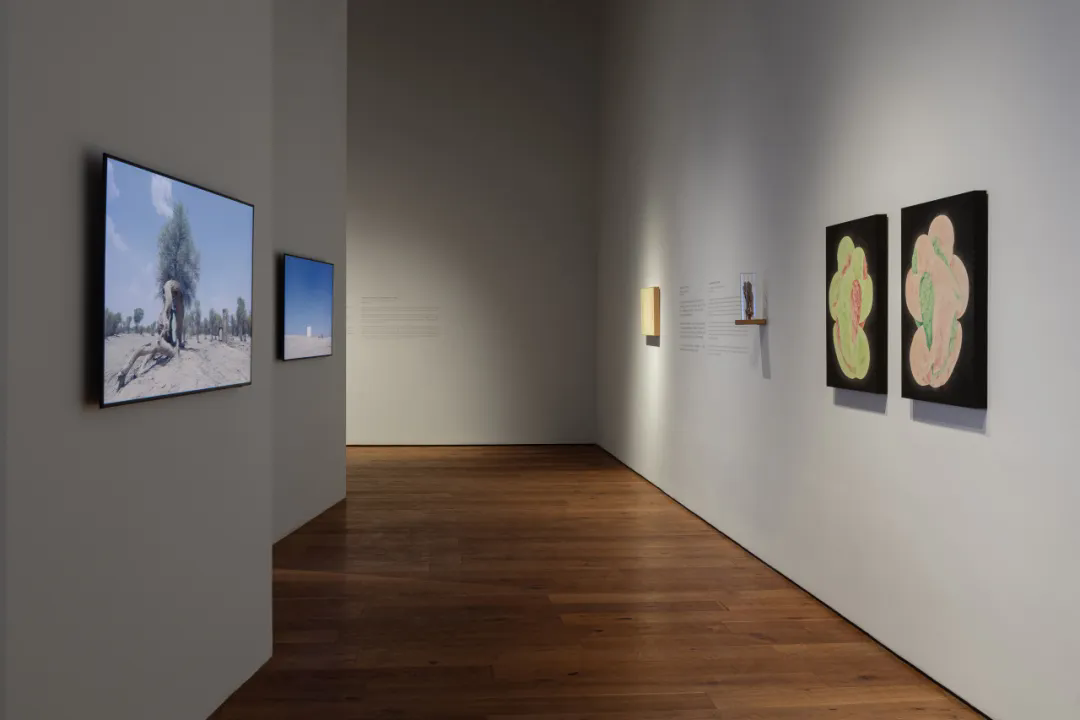 Installation View of “Observing My Distant Self Kang Chunhui”, 2024.5.25-8.18, INKstudio
Installation View of “Observing My Distant Self Kang Chunhui”, 2024.5.25-8.18, INKstudio Tarim Poplar Forest 84°11′35E-41°15′35N (screenshot), Color Video, sound, 06’06”
Tarim Poplar Forest 84°11′35E-41°15′35N (screenshot), Color Video, sound, 06’06” Lop Nur 86°25′20E-41°20′38N (painting), Ink and mineral pigment on paper, 42 x 56 cm
Lop Nur 86°25′20E-41°20′38N (painting), Ink and mineral pigment on paper, 42 x 56 cm Lop Nur 86°25′20E-41°20′38N (screenshot), Color Video, sound, 06’06”
Lop Nur 86°25′20E-41°20′38N (screenshot), Color Video, sound, 06’06”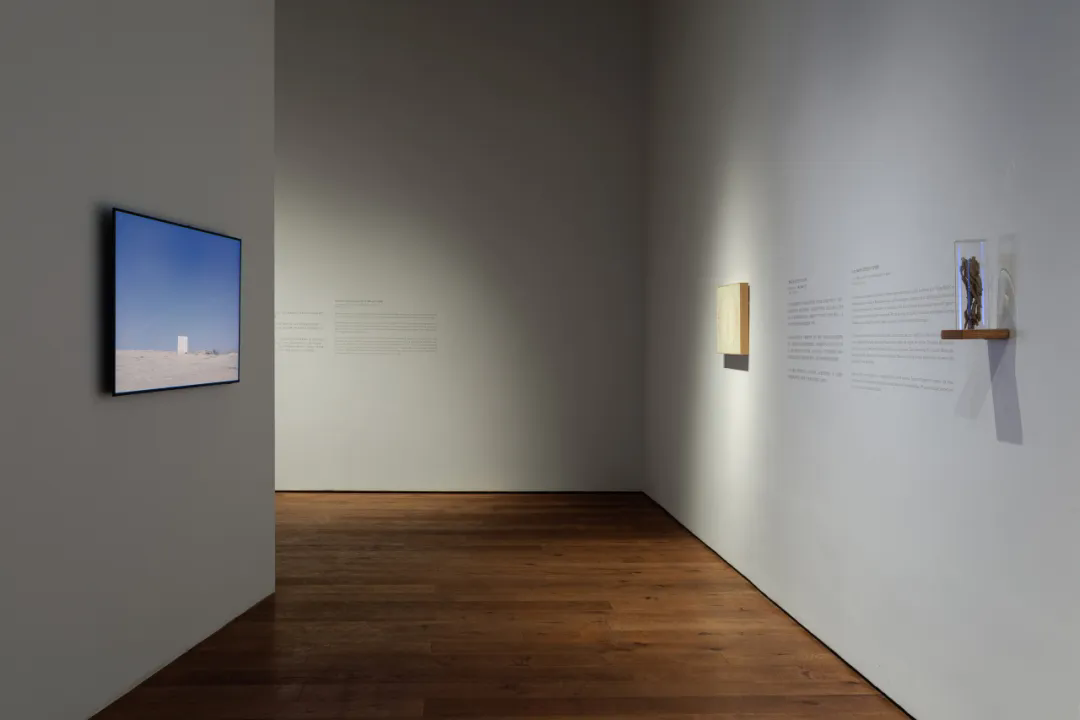 Installation View of “Observing My Distant Self Kang Chunhui”, 2024.5.25-8.18, INKstudio
Installation View of “Observing My Distant Self Kang Chunhui”, 2024.5.25-8.18, INKstudio
What’s interesting is that antithetical parallelism, or antithesis, is an aesthetic element that traditional Chinese culture has always loved. Appreciating the antithesis can be a specific state of tension, the entanglement of fate, or it can be the two ends of boundary, which become mirrors and references that reflect each other, containing a lot of tolerance for differences. Perhaps like Kang Chunhui’s description of the boundary, “it is not an obvious narrow dividing line, but a broader zone.”
 Installation View of “Observing My Distant Self Kang Chunhui”, 2024.5.25-8.18, INKstudio
Installation View of “Observing My Distant Self Kang Chunhui”, 2024.5.25-8.18, INKstudio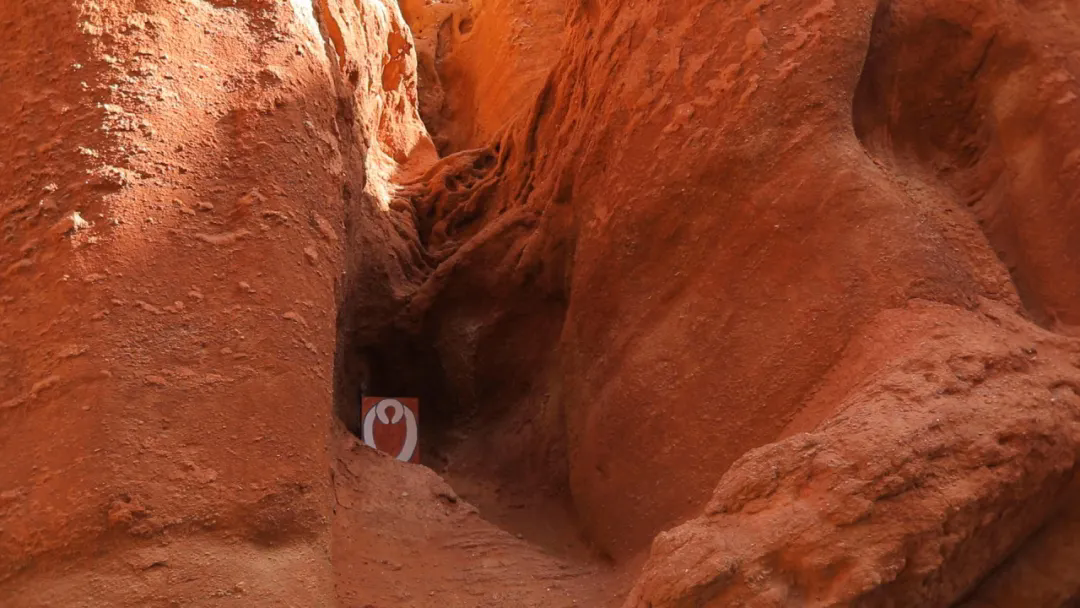 Tianshan Grand Canyon 83°05′35E-42°11′52N (screenshot), Color Video, sound, 06’06”
Tianshan Grand Canyon 83°05′35E-42°11′52N (screenshot), Color Video, sound, 06’06”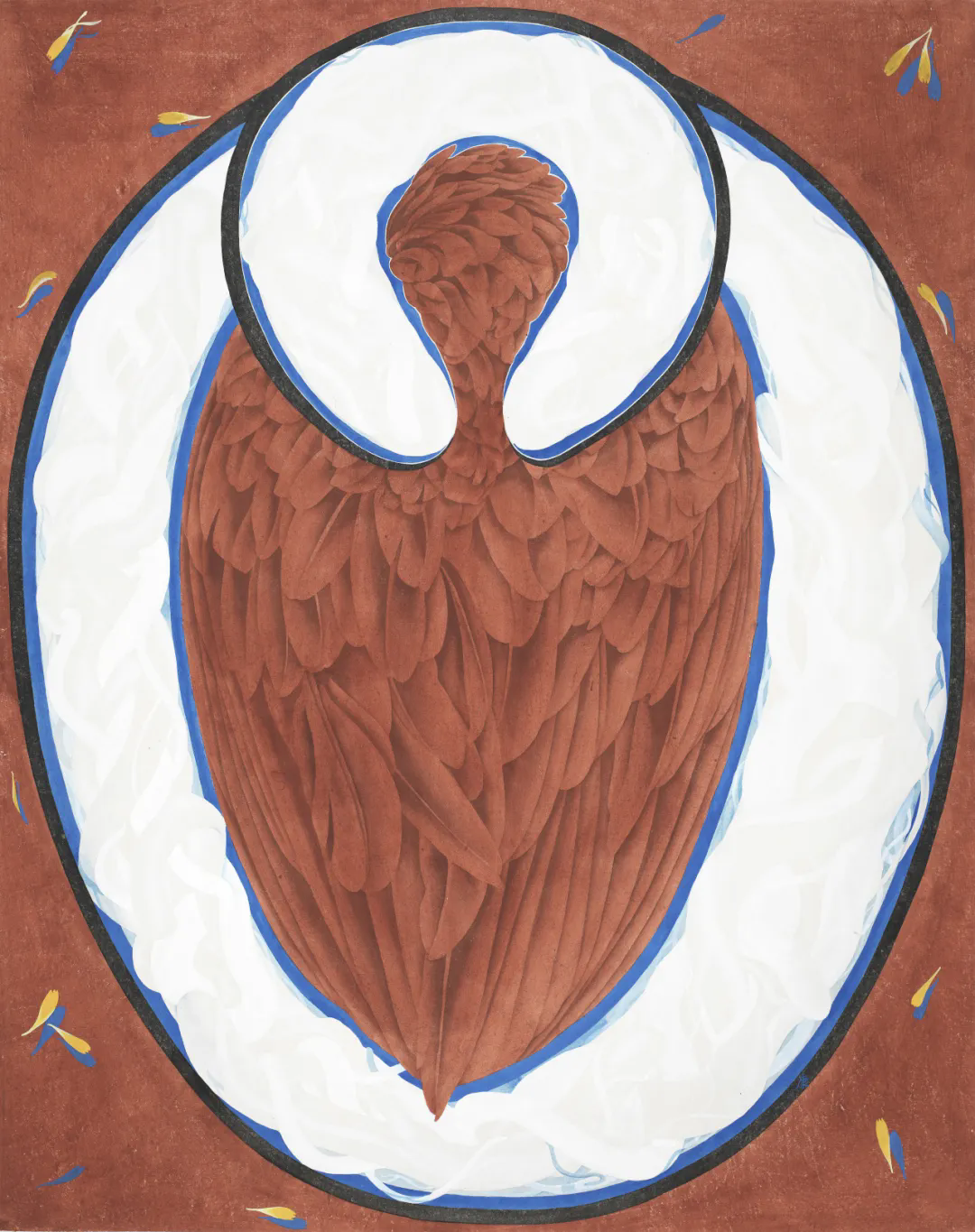 Tianshan Grand Canyon 83°05′35E-42°11′52N (painting), Ink and mineral pigment on paper, 90 x 71 cm
Tianshan Grand Canyon 83°05′35E-42°11′52N (painting), Ink and mineral pigment on paper, 90 x 71 cm
III. Chinese Painting as an “International Language”
Kang Chunhui hopes to continue to explore more “strangeness” from the Chinese painting that she is extremely familiar with. How to use her own methods and practices to loosen the clear and slightly solidified tradition again, or even “make it flexible,” is perhaps one of the challenges that contemporary Chinese painters have to confront.
 Morning Clouds No.18, 2022, Ink and mineral pigment on paper, 39 x 32 cm
Morning Clouds No.18, 2022, Ink and mineral pigment on paper, 39 x 32 cm
The second part of the exhibition focuses on the artist’s continuous exploration in creation before and after she completed the Xinjiang art project. Her impulse to blur “the boundary” goes a step further, the interweaving collision of different cultural elements jointly demonstrate her current direction, that is how to find and open up a freer, and richer creative possibility in the constant tug-of-war between destruction and establishment, tradition and innovation. “This is not a goal that can be achieved through interpretation, but once it appears, it cannot be easily defined,” said Kang.
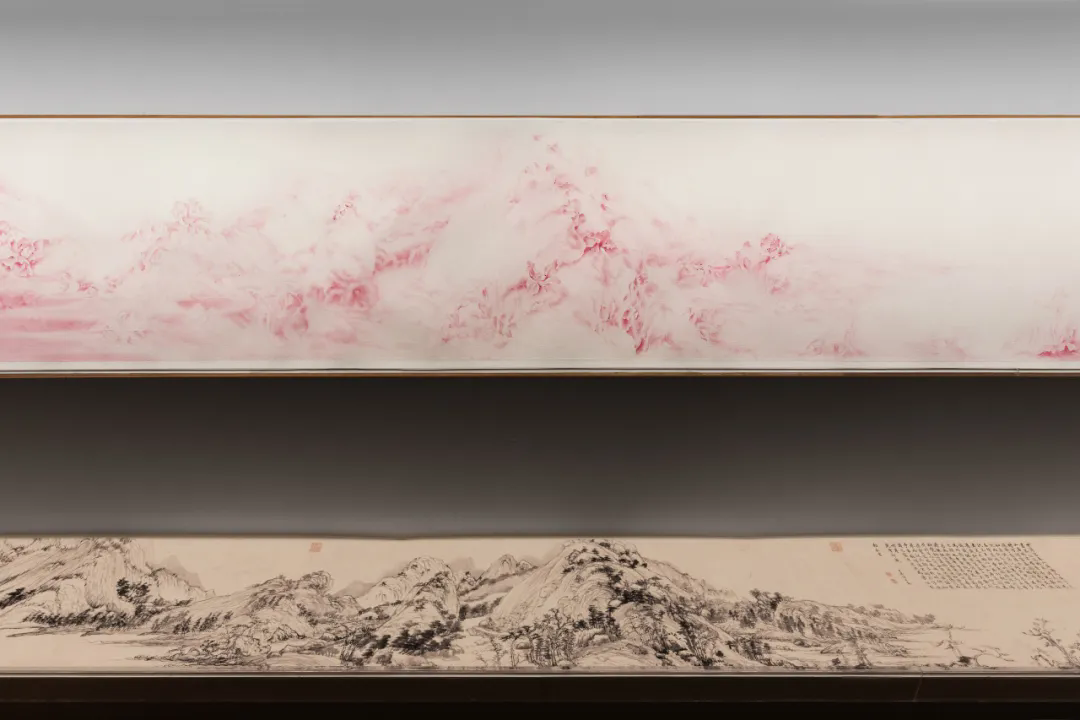
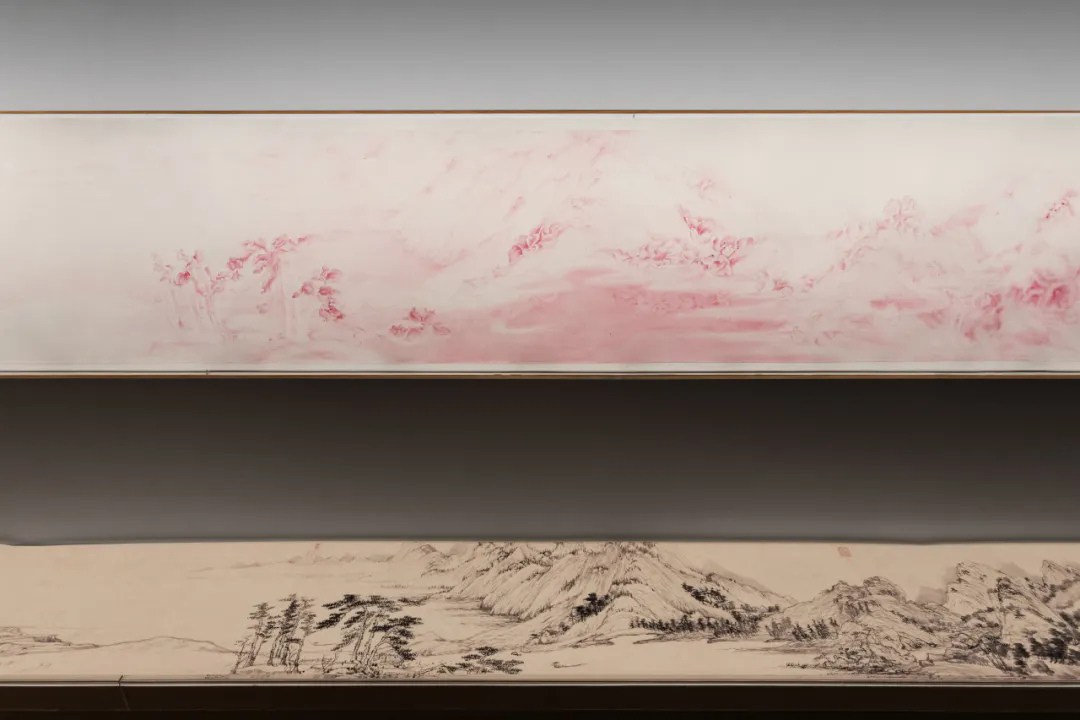 Installation View of “Observing My Distant Self Kang Chunhui”, 2024.5.25-8.18, INKstudio
Installation View of “Observing My Distant Self Kang Chunhui”, 2024.5.25-8.18, INKstudio
In The Hidden Protagonist: Mount Fuchun, Kang Chunhui transgresses the traditional boundary between xieyi or “calligraphically expressive” and gongbi or “meticulously descriptive” painting while interrogating the dialogical relationship between self and history through the landscape. She depicts prostrate petals and folding bloom forms using softly-graded color wash, through which she intervened in the world of literati painting that was traditionally dominated by male literati groups. Also, she tries to draw from the huge and solid tradition of literati painting that has lasted for nearly 600 years, but to open up a new creative vein from the interlocking inheritance system of brush and ink, texturing techniques, and interest.
 Installation View of “Observing My Distant Self Kang Chunhui”, 2024.5.25-8.18, INKstudio
Installation View of “Observing My Distant Self Kang Chunhui”, 2024.5.25-8.18, INKstudio Sumeru No.21 (diptych) , 2023,Ink and mineral pigment on paper, 130 x 120 cm x 2
Sumeru No.21 (diptych) , 2023,Ink and mineral pigment on paper, 130 x 120 cm x 2
The artist’s interest in materials does not only continue the handicraft tendency of traditional craftsmen, but it also involves considerations of conceptual transformation arising from materials. Mineral pigments are applied in both Eastern and Western murals, such as mineral green, azurite, lapis lazuli, chalk, kaolin...Kang Chunhui prefers to use local materials and grind them by hand to make pigments. Whether it is the red color that she painted the Tianshan Grand Canyon, or the white color she used for the background of the Sumeru series, which she calls “cosmic color” (she discovered the white mineral pigment made by grinding ancient animal fossils in Xinjiang, and it is similar to the average color of cosmic luminous objects calculated by scientists who work for NASA, that is, “the superposition of all the light in the universe”), which adds an intriguing dimension of time and space to the painting.
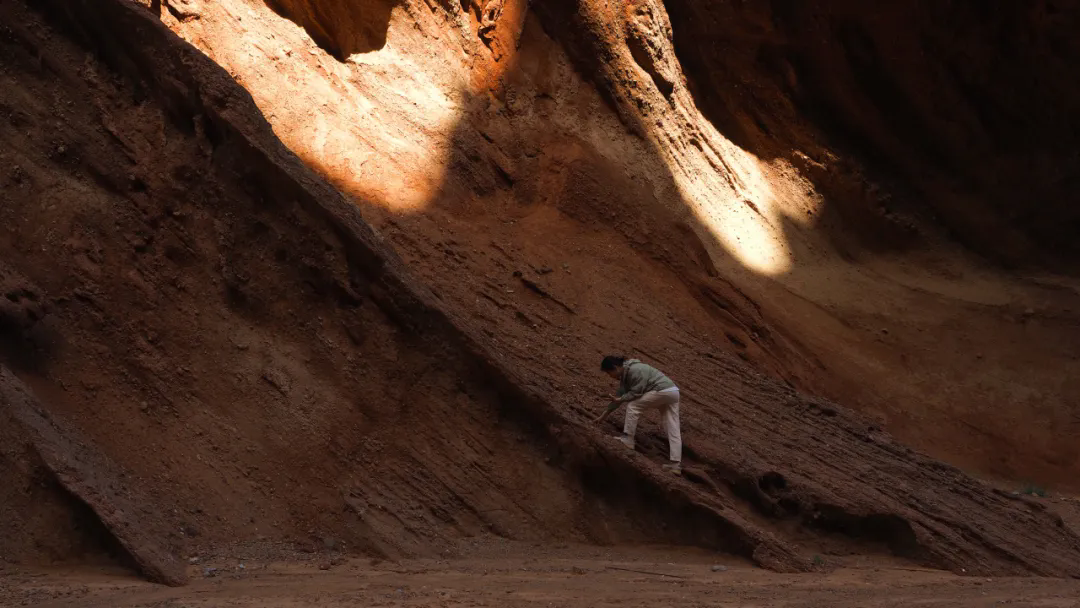 The artist collected mineral pigments in Tianshan Grand Canyon.
The artist collected mineral pigments in Tianshan Grand Canyon.

 The artist made mineral pigments.
The artist made mineral pigments.
In the artist’s philosophy, “What we see and feel are all left behind by time, and time ultimately chooses the colors left behind, making them more clear... Using ancient pigments has accelerated the process of my life, they jointly allowed me to gradually step into a new stage.”2 The basic elements in the soil treat different cultures equally and form the colorful world, just like the artist tries to view the world equally and construct her art world.
In addition to her alchemical exploration of pigments, Kang Chunhui’s works are replete with symbolic, philosophical, and mythical references from seemingly disparate cultural traditions—what she refers to as her “hidden protagonists.”
 The Hidden Protagonist No.2 (diptych) (one of them), 2022-2024,Ink and mineral pigment on paper, 200 x 103 cm x 2
The Hidden Protagonist No.2 (diptych) (one of them), 2022-2024,Ink and mineral pigment on paper, 200 x 103 cm x 2
The Hidden Protagonist No. 2, was completed in 2024 after three years of meticulous development. This monumental diptych employs both organic and mineral pigments—in one panel, blue and green pigments predominate, in the other red and yellow. Concealed within the multi-layered folds of floral blooms and avian feathers, however, are two human figures—Kang’s “hidden protagonists.”

The Hidden Protagonist No.4, 2024, Ink and mineral pigment on paper, 72 x 59 cm
Kang Chunhui’s works might introduce a new possibility: Can Chinese art be re-positioned on a broad and fluid world map, and can it be regarded as an art with an international origin? Just as it did in the early stages of the Northern and Southern Dynasties, Han and Tang Dynasties, Chinese art, especially grotto murals, had in-depth exchanges with Central Asia, India, Greece and Islamic cultures in materials and styles of art expression—or it can be calls as a precolonial “international art.”
Text (CN) by Mengxi, abridged (EN) by Sue/CAFA ART INFO.
Image Courtesy of INKstudio.
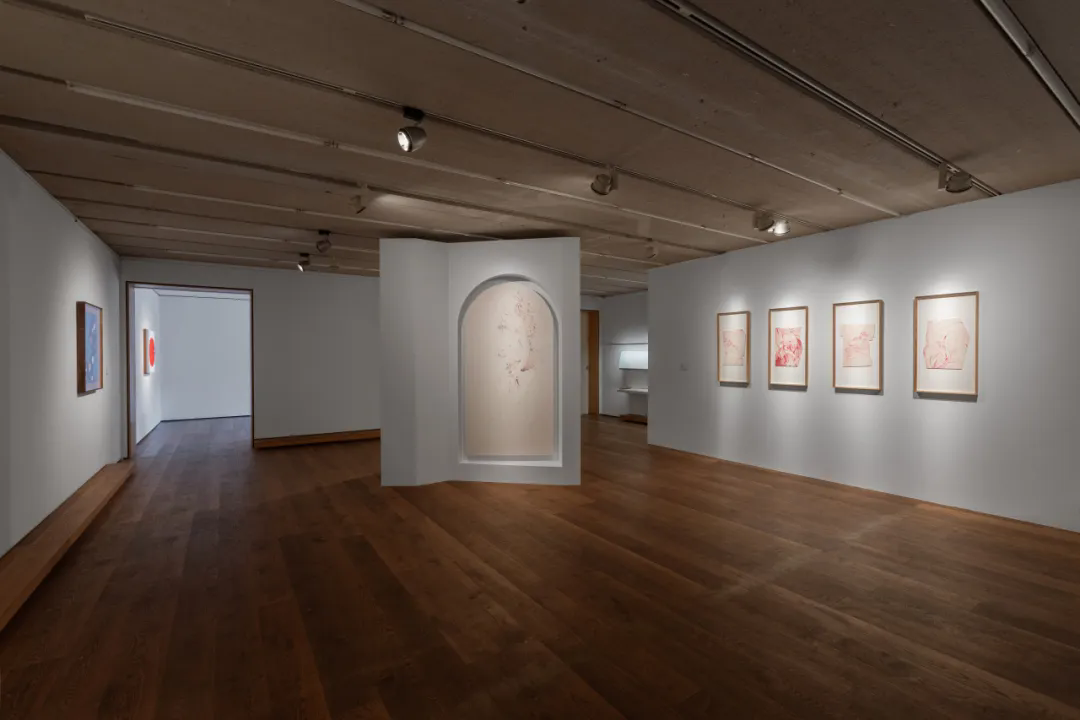
 Installation View of “Observing My Distant Self Kang Chunhui”, 2024.5.25-8.18, INKstudio
Installation View of “Observing My Distant Self Kang Chunhui”, 2024.5.25-8.18, INKstudio
Notes:
1. Quoted from“Kang Chunhui: Transition, Location, Displacement”, by Zhu He
2. Quoted from Artist Statement by Kang Chunhui
 About the Exhibition
About the Exhibition
Dates: 25 May - 18 August 2024
Venue: INKstudio
Tel: +86 10 6435 3291
Address: Red No. 1-B1, Caochangdi, Chaoyang District, Beijing, China 100015



